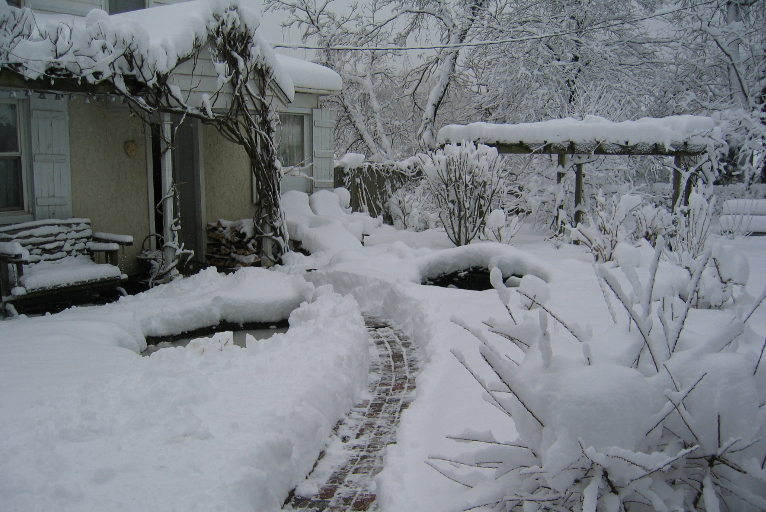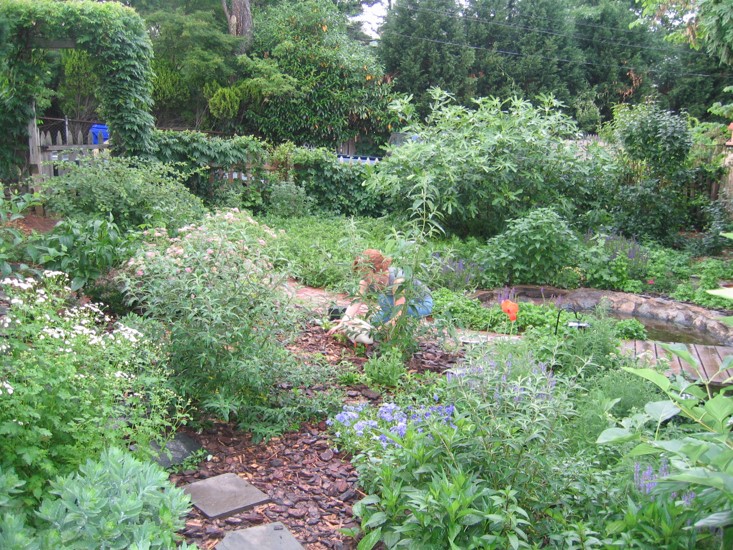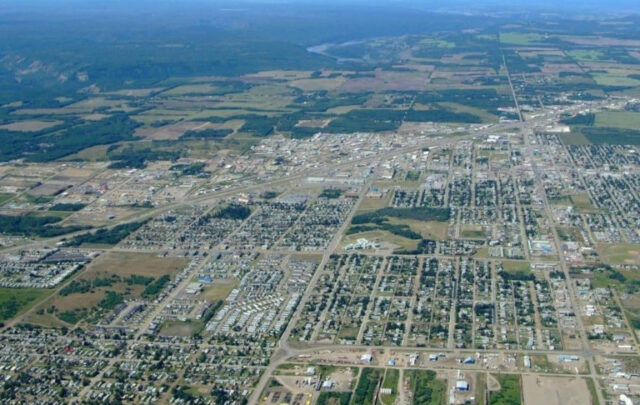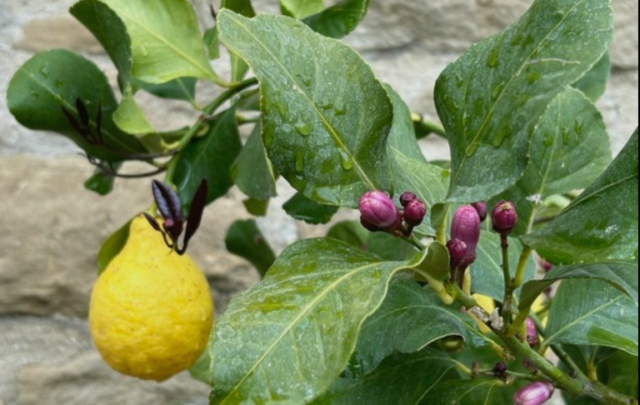A new year. A new cycle. In January I am in hibernation. I use the month to toss out the last year’s projects which didn’t take root, leaving room for new ones to grow. And I ruminate on what worked in the past and why. I wasn’t born to farming; I came to it in middle age, after half a lifetime living in big cities. I became increasingly passionate about the job—and protective of the environment in which it takes place—as I grew in experience. Why do we take up farming, especially those of us not born to the land? What magic lures us? As the challenges increase, why do we keep going? Each year I ask myself do I want to continue? I am signing up again for another year. I cannot imagine doing anything else. I cannot imagine loving doing anything else as much.
1986. A Beginning…. I became a farmer by accident because a delivery truck broke down. I was in my studio working on an impossible deadline. My third baby was upstairs, crying with the babysitter, when a friend came to the door. My friend, a chef, was also on a deadline. The delivery truck, with her weekly order of fresh herbs, hadn’t arrived. Standing at my front door with a pair of rose clippers in her hand, she asked if she could cut some of my overgrown rosemary. I said sure and went back to work. A few minutes later she popped her head into my studio, her arms full of rosemary and handed me twenty dollars. I laughed at the absurdity and refused it. She insisted. I took the money. That was Epiphany #1, that I could make money on what was growing in my front yard. I lived across the street from the an organic food coop and the next day I brought them some random cuttings. They said, yes, they would buy my herbs.
I quit my job. I paid the babysitter for one more week and drove her home for the last time. The truth sounds ridiculous. It was so simple. I would have the luxury of staying home with my baby, make some money, while working for myself, and working outdoors.
Living in New York City and Washington D.C. until my late thirties, I had missed the memo on how to be a modern farmer: that, in order to feed people we must have enormous tracts of land far from the cities, monoculture crops, fertilizers and pesticides, and bank loans for the machinery of the Green Revolution. Much of what I do—what I fell into really—is rooted in millenia-old practices. I grow our food and most of our medicines in the company of The Grandmothers, the ancestors with a pouch of seeds and a digging stick. Our inventory requires little more than a few hand tools and saved seeds. We add to our soil’s fertility with our waste. We save rainwater. Our hands, not tractor tires, are in the soil. We walk behind Mother Nature, watching closely. We pay attention as these days she is often changing her dance steps. Without the benefit of Monsanto, Dow Chemical, Aramco, or John Deere, I grow food for my family and friends with enough left over to sell.
But back then we were recently transplanted to a small house on the edge of D.C. I had planted the front yard with a generic herb garden as a protest against a lawn. The herbs were there by default, because they were easy. I had seen pots of parsley-sage-rosemary-and-thyme—that should date me—at a nearby supermarket. I dug a hole and stuck each plant in the earth. I added nothing else to the soil. I also planted a bare-root fig tree, six peach saplings, and a few grape vines all found on sale at the front of the hardware store down the street. The total cost for beginning my garden was less than one hundred dollars. Maybe less than fifty. Had I thought about seeds, if would have been cheaper. I planted in small clumps, going for a random look, enjoying the look of different colors and textures together. Once the intentional planted plants took off, the weeds arrived. First to take up residence were calendula seeds which must have hitchhiked in with the culinary herbs. Along with the weeds, they sprouted and colonized everywhere. I left them all. They filled in a lot of blank spaces. Abandoned to their nature, the perennial herbs grew leggy, flopped over and rooted where the stem touched the ground. The annuals and biennials self-seeded with abandon. I never sprayed. I never weeded. I never fertilized. I rarely watered. The peach trees succumbed to marauding squirrels as soon as they set fruit. The fig tree, grapes and all the herbs and weeds stood up to anything Nature could throw at them. What survived that first year was pure hard-core resilience.
That first garden knew just what to do. Culinary herbs—those originally from Europe—have a long history as hardy versatile plants; they can deal with freezing temps yet handle being hot and dry. Their essential oils, which greatly enhance our cooking, are natural insecticides. All I had to do after planting them was to stay out of their way and let them grow and reproduce. I spent the first morning of my new job cutting back whatever plants were out of control. I tied them in small bundles with twine, stuck in a slip of paper with my name and phone number and brought them to the coop in a cardboard box. I received two dollars for each bundle. I was paid forty dollars. The coop’s produce manager called weekly. Sometimes twice a week.
The common wisdom at the time insisted that I compost. Though the garden had prospered up until that point, now I was asking for it to work harder, to give me constant new growth to sell. I would need to be feeding the soil ecosystem a few extra meals. Delivering to the coop in the early morning I watched as they cleaned all the vegetables for the day. It amounted to an astounding amount of garbage, a trash bag full of outer lettuce leaves and veggies not quite fresh enough for their customers. All were certified organic. My first week as an organic herb farmer, I offered to ‘recycle’ their garbage. That was Epiphany #2, beyond paying for those first herbs, grape vines and the fig tree, I didn’t need to buy anything! Our waste would feed the soil. I made compost heaps in the side yard of coop produce. Really, compost heaps sounds more organized and intentional than it was. No, I just dumped everything in piles. It took a month for the pile to shrink to one third its size and look unrecognizable enough to tuck around the growing plants. I knew nothing about nitrogen levels or sequestering carbon. I would have had rats for sure except we had cats. But the compost was good enough. The garden prospered.
A few neighbors began to buy from me. It was a no-brainer to sell to them for more than I could get wholesale from the coop. The rosemary grew right through the winter, developing beautiful blue flowers in December. I had more of that than anything else, so I made that my focus. I sold all the flowering rosemary to a caterer who used it in everything she made for the Christmas and New Year’s parties. Her signature dish—a baked wheel of brie smothered in peach chutney—was decorated with a garland of rosemary.
That first year was a success only because I stuck with what worked for me, what I could do easily. I had chosen hardy perennials which were perfectly suited to where I lived. They were from old seed lines and drought resistent. I did not expand my inventory. I invested no money. I hired no help. I did not listen to the financial advisor my husband brought over. Anything more than what I was doing—seeding new areas, renting garden space, adding vegetables, increasing the ‘client base’, building greenhouses and hiring help—was beyond what I could do without stress. I was making money on less than 1000 square feet/93 square meters, while spending nothing. Perhaps I took in as much money as a conventional farmer after he has paid for labor, bank loans, machinery, storage facilities, gasoline, fertilizers, pesticides, herbicides, and seeds. But those were just the practical reasons for keeping it very simple. There were unexpected farming delights too.
Two years after beginning my oldest child got with the agricultural program and brought home six newborn chicks. They were installed in the bathtub. My kids played with them for hours. They became a magnet for pulling in the neighbors’ children. My next door neighbor made a ‘poultry traveling cage’ and his children took our birds to school for show and tell. Other neighbors brought kitchen scraps for them to eat. I never bought chicken feed. The birds cruised the yard during the day and drank water out of the dogs’ water bowls. (They also slept in the house, which made them legal pets rather than farm animals.) When the eggs began coming, I had a waiting business in the neighborhood. I couldn’t possibly satisfy it. I adopted a few ducks from an overcrowded county sanctuary. They slept in the kitchen and ate the cat food. During the day, they excavated for worms and eliminated every slug and snail in the front yard.
In my first few years of farming I made one major upgrade, a stone duck pond fed by stored rain water. I hired the friend of a friend, the man who had made the stone ponds at The National Zoo. We found the stones. We helped with the work. He brought his expertise and the cement. When the garden was dry, we cleaned the pond, dumping water saturated with algae and duck shit on the garden. The compost quickly became redundant and I thought about selling it. But I had paid nothing for it and so I left what I could not use on the driveway, free for the taking.
The neighbors were interested in what I was doing and supported me. One neighbor—a close friend and our lawyer—incorporated me as a gift. (She said that she didn’t want to me to lose my house when I was sued.) When I stopped taking out the coop garbage, another neighbor gladly took over. The baby did not need entertaining. She played in the soil, digging with a large spoon; planting leaves and sticks and her brother’s toy dinosaurs right next to where I was working. She was the darling of the coop and all my clients. She loved it. I loved it. At nightfall, I had to call her in from singing in the garden.
As the plants took root and expanded or self-seeded, tiny ecosystems—guilds of plants (different species which like to hang out together, enjoying the same pH and soil critters) sprung up all over the front yard. The diversity of these clusters brought a wildness to the front yard. The plants chose where they wanted to be, strengthening the resilience of the plant community. To call it natural would have been pushing it. But it was close enough to be self-sustaining. And I found it beautiful. I felt exhilerated every time I came home and walked through the gate. Friends came over just to sit in the front yard. At times, I would see a stranger standing at the entrance, seduced by the garden while waiting at the bus stop outside my fence. I moved a bench and chairs to the front of the house and took my tea there in all but the worst weather. That was Epiphany #3, that growing food was about more than income, food security, and community building. It was also about natural beauty and what it meant to be living within it, just being part of it, not controlling it. Wildlife found their way to the garden. Birds arrived to nest. Opposoms and raccoons visited. Black snakes used the rafters of our shed to shed their skins. A turtle laid eggs in our pond. Then a frog. And when the herbs flowered, exquisite moths, bees, and butterflies came. The front yard farm, as small as it was, became a busy, productive and self-sustaining ecosystem.
When the baby went to back to school, so did I. I loved learning the biochemistry of the plants and soil organisms but it did not change my basic philosophy. By the time she went to university we had outgrown the city farm. We moved far away, to the mountains, to land which was mostly woodlands. On a practical level, a small yard growing herbs—even with chickens and ducks—was hardly food security. But it was an excellent beginning. Long before we moved on, those raccoons and turtle eggs and edible weeds had changed our lives. Once we understood the intrinsic value of the natural world, not just what it contributes to our well-being, our economy and the local ecology, there was no going back. It was not the reason I began to farm but it was one of the reasons I continue to sign up to do it again.
RANDOM NOTES: How to begin… baby steps.
*There is a name for what I was doing, though I didn’t know it at the time. Do-Nothing Farming. If you are interested and want to buy one book (or borrow one from the library) consider Masanobu Fukuoka’s The One-Straw Revolution on exactly that. 1975. If you want a second book, consider The Reader’s Digest Magic and Medicine of Plants, 1986. It is a very simple resource—still up to date. It is the one I used for my front yard farm, especially for learning the benefits of the plants we call weeds.
*It is absolutely possible, easy actually, to grow food and sell the surplus with no expenses other than the initial seeds/plants, a few hand tools, and taxes. Community gardens are growing everywhere. Land can be borrowed. You can work a neighbor’s/friend’s backyard in exchange for sharing some of your produce. If the soil must be amended, we are drowning in waste which can be buried directly in the soil where you want to grow next season. Tools, excellent tools infact, can be purchased at garage sales and flea markets. If you are starting small you will not need machinery. If you grow large, you can accept apprentices instead of buying machinery.
*Volunteer. Work with a local farmer, a neighbor perhaps, someone planting for the area, the climate, for resiliency in the face of unpredictable weather. Someone selling locally. Someone connected to a city garden. Or join a CSA in the country. Volunteer on weekends or after work. Get your hands in the earth. Sow seeds. Harvest crops. Try to stay an entire season. Better if you can stay one year. You will learn. Or apprentice through www.wwoof.net Most countries have a WWOOF program which places a willing pair of hands with an organic farmer for two weeks or more. A place to sleep and meals are provided in exchange for 4-6 hours of work a day. Every farmer, every farm is different. We all need help and prefer to not pay for it. It only adds to the price of the food. You will know what you want to grow, where, and how within a short time.
There is so much one can learn about resilient farming by observing and helping out. No book or online/classroom course can teach you about the conditions on the land where you live and the plants which prosper there. It is an invaluable help to apprentice locally, to see what is being done in your city or neighborhood, before you set off on your own. The best possible way to learn is by first hand observation—of a sustainable farmer and the natural world around you.
Zia Gallina. January 2023.
© La Bella Terra, Assisi, Italia
Teaser photo credit: My front yard farm. January 1990








